

Vol. 38 (Nº 09) Año 2017. Pág. 16
Claudio BENEVENUTO de Campos Lima 1; Rodrigo NUNES Ferreira 2; Gilson BRITO Alves Lima 3; José Francisco TEBALDI de Castro 4; Vladimir STEFFEN Pinto 5; Danilo GARBAZZA Vieira 6
Recibido: 08/09/16 • Aprobado: 12/10/2016
4. Experimental setting and testing
ABSTRACT: Pre-salt is an impressive oil discovery to be developed in Brazil. The major challenge to the implementation of future oil offshore platforms in this area is the processes redesign to a new reality, where the complexity will require the tasks to be carried out in a simple, safe and efficient way. In the traditional working processes, the platform control is on board, by professionals dedicated exclusively to the operation of the production plant in supervisory control rooms. A Brazilian oil operator is implementing a new approach to remote control the production from collaborative environments located in the offices. This article addresses one important question: is the telecommunication infrastructure enough to this reality? This research aims to apply an analysis method of the latency variation of messages exchanged by the supervisory system, including the remote environment in town and an offshore petroleum platform. The method proposed in this article considered three scenarios involving satellite infrastructure, showing that there are significant differences in each situation, providing the identification of the latency interval necessary to prevent any delays in the logical operations sequence. It was concluded that the remote operation is workable with satellite transmission system. This work has contributed in supporting the development of additional mechanisms to reduce the transmission delay, allowing remote operation over high latency telecommunications systems. This research is an enabler to the remote operation projects implementation using satellite systems. |
RESUMO: Com a descoberta do pré-sal, uma reformulação dos processos de trabalho será necessária para atender a demanda da produção dos novos campos de petróleo. Devido ao número crescente de atividades operacionais realizadas em terra, resultado principalmente da operação remota das plataformas de produção, o tempo de resposta nas transmissões de dados entre as plataformas e os centros de operação é requisito para a viabilidade deste modelo de operação. Porém, enquanto a malha óptica não está implantada, a infraestrutura de rede de telecomunicações atual tem como obstáculo para a operacionalização dessas plataformas a utilização de um sistema de transmissão satélite de alta latência. O objetivo deste trabalho foi a aplicação de um método de análise empírica sobre a variação de latência das mensagens trocadas pelo sistema Supervisory Control and Data Acquisition (SCADA) entre o ambiente remoto localizado no continente e o ambiente localizado em mar nas transmissões via satélite, por meio de três situações reais de operação. Com os resultados desta pesquisa foi possível definir os requisitos de latência necessários para operação remota via satélite e o desenvolvimento de mecanismos para a redução de atrasos gerados pela rede, auxiliando na elaboração de projetos em que o desempenho seja significativo. |
The impressive oil discoveries in Brazilian Pre-salt created a new reality in the oil and gas industry. In order to increase the Brazilian oil production by the end of this decade, many technological challenges must be overcome, such as the distance of the reserves from the coast, the high water depth and the complexity of the reservoirs. The logistical effort will intensify with many new production systems. This scenario will require a significant change in the way processes are managed. The major challenges to the implementation of future Pre-salt petroleum platforms is redesigning the processes to this new reality, where the complexity will require offshore processes carried out in a simple, safe and efficient way. In the traditional working processes, the production control is on board the petroleum platform, by professionals, dedicated exclusively to the operation of the production plant in supervisory control rooms. With the operationalization of the Pre-salt, the offshore process plant will be remotely controlled from the onshore base, in collaborative environments located in the company´s offices.
In general, a petroleum platform receives fluids from wells, separates gas, oil and water and exports these phases through pipelines or vessels. Every processing plant is controlled by the supervisory system team. Due to the challenges of the oil industry, many initiatives have been implemented to bring onshore all the work that doesn’t need to be done onboard the platforms, in order to lower the human exposure to the risks involved in production operations, reduce trips to the offshore unit and increase the availability of experienced experts. So, it’s possible to provide a better management of the activities, in a centralized way and with decreased operating costs. The production development of these oil fields requires an increasing number of operational activities onshore, including the remote operation of production units. This work process, redesigned to integrate people and information, is a worldwide policy of the oil operators. There is a multiplicity of names to the Digital Oil Field, coined by oil companies, some of which are Digital Oil Field of the Future, Smart Fields, Smart Wells , iField, iWells, eField, and Intelligent Field (Cramer et al, 2012).
Santos Basin is one of the largest Brazilian sedimentary basins, where important oil fields were discovered by a major energy company, with a huge production potential in ultra-deep waters. This area is located Southeastern Brazil and known for the oil reservoirs in the Pre-salt. Because the distance from the coast is greater than 300 km and the complexity of the wells, the production development of these oil fields presents technological challenges, such as telecommunication and logistics, which usually require work processes redesign and an increasing number of operational activities to be carried out in the onshore offices. In traditional working processes, operation and supervision of the production plant are conducted on the offshore production platform by professionals exclusively dedicated to operation, in local supervisory control rooms. The main motivation for remote operations is to reduce operating costs with the implementation of new projects. Remote operations have been implemented in the oil and gas industry, with significant progress made through workflow and process design, enabling remote monitoring, execution, and control (Breu, 2007). According to Levett (2006), the main result of integrated operations is a large number of onshore operation centers, with the goal to increase safety, reduce costs, enhance collaboration and promote better decisions. The point is to make real-time data available anywhere and to support this extended data access with work processes for optimum operation.
Because of the high response time present in satellite systems, the world's oil companies consider fiber optics telecommunications infrastructure as a premise for performing remote operations. Skourup et al (2008) completes that operating earnings from this type of operation justify the execution of telecommunication projects with low latency and high availability systems. Understanding the delay performance characteristics of packet switched networks greatly facilitates delay performance analysis of net computing systems. This is particularly important to grid applications with low latency requirements. The protocol network analyzer flows generated from distinct sources merge together and compete with each other to access available bandwidth from the outgoing links at the packet switches (Falk & Fries, 2009). While the optical net is not deployed, the biggest challenge for remote operation of future Pre-salt platforms is the infrastructure of telecommunications networks, currently served by dedicated satellites, whose intrinsic latency characteristics influence transactions between the supervisory system, remote environment on land and the oil platform system.
The most common supervisory system in the oil industry is SCADA (Supervisory Control and Data Acquisition). It is responsible for controlling the entire production plant. To represent a real scenario, the delay in the logical sequencing of an operational action, open à close à open, by a remote SCADA system, can change the conditions specified for the product (oil or gas) even may create risks considering operations with high pressures and temperatures. Situations such as sequencing error, caused by variation in latency communication between SCADA systems, may bring the platform interlocking system to perform a plant partial or total shutdown, causing considerable production losses. Thus, a better understanding of the behavior of the satellite network latency variations can help in the design, choosing of more appropriate protocols and infrastructure, avoiding negative impact on the performance of remote operations.
This article aims to apply a method of analysis of the latency variation of messages exchanged by SCADA System, between the remote environment onshore and the petroleum platform, in satellite transmissions, using three real operational situations from supervisory actions: (1) chemicals injection pump of the submarine system switch, (2) verification of the vessel level after the shutoff valve operation and (3) identification of an event generated by the inert gas detection system. There is no interdependence of the controls, only an increase of complexity in the execution, so that it was possible to evidence the successful realization of the supervisory actions. Also, this study quantified the effect of the variability of latency in each situation above and it was possible to identify the platforms with service conditions in telecommunications infrastructure. This step was mandatory to execute the remote operations model and to help in the definitions of the requirements needed to improve it. This architecture can be applied for other operations segments in this industry.
The originality of this research is based on the analysis of the latency supported by statistical parametric tests. In that way, it was possible to present a telecommunication solution to an oil platform remote operations scenario, where the fiber optics infrastructure was not in place. This work contributes in supporting the development of additional mechanisms for reducing the transmission delay or allow remote operation over high latency telecommunications systems, which is a recent case in the oil and gas industry. Furthermore, the proposed architecture model could be used for other needs of remote operations, as in the drilling rigs segment, ship ballast control systems and moorings, dynamic positioning, among others. In the remote operations analyzed by Skourup et al (2008) and Levett (2006), the communication systems requirements assume having low variation in latency. Unlike a laboratory test in which all the variables might not be considered, the real scenario of high latency analyzed by this work provides an operational model to remotely operate a number of applications that rely on satellite system as the transmission technology.
According to Boon & Fook (2003), the advantages of remote operations on an oil platform are related to the operational availability of the unit improvement, reducing the operator's response time to restore the operation in case of unexpected downtime shutdown and the optimization of required personnel work by the introduction of automated process control systems, contributing to increase operational safety. According to Levett (2006), the benefits of remote operations for oil and gas production platforms are abound, such as: reducing operating and maintenance costs, reaching the limits between 15-20% of the value estimated for the maintenance by professionals on board, less production shutdowns caused by instrumentation problems, operational safety increase by preventive maintenance of critical equipment, alignment of the operation and other petroleum specialties (engineering, automation, reservoirs and lifting), giving a boost to the effective implementation of collaborative centers. This brings value to the operation, optimization and maintenance experts, which can remotely help in the operation of several platforms.
In an oil platform local control room, a set of systems can be found. SCADA Systems are important on the monitoring of the production processes information and also the physical facilities, made by the acquisition, handling and presentation of process and control/actuation variables to the users (Junior, 2006). Figure 1 shows the communication architecture of a SCADA System on a platform. SCADA nodes, which communicate with a Programmable Logic Controllers (PLC), are represented at the lower part and the terminal server is shown in the middle of the figure. The clients of the terminal servers are at the top.
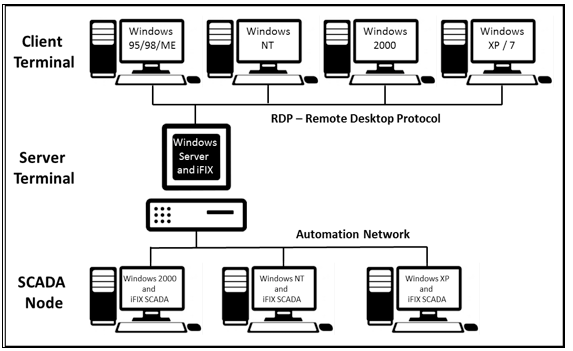
Fig. 1 Proficy iFix using Terminal Server
Adapted from Gilsinn (2003)
The protocol used in this connection is the Microsoft Remote Desktop Protocol (RDP), which uses short bandwidth communications that is one of the important features for remote operation with satellite network as a communication system (Cronbach, 2004). In the oil industry, there are several limitations of the possibilities of transmission technologies caused by the production units location, usually with restricted bandwidth (Ellender, 2005). In these scenarios, even if telecommunications systems with redundancy and high availability are adopted, it should be considered a contingency plan taking into account the total communication loss with the oil platform, involving the offshore teams. In this article, the variation in latency of messages exchanged in satellite transmissions by the SCADA System between the remote environment onshore and the offshore facilities was analyzed. The main variables manipulated are alarms, operation modes and production data.
As they are considered critical variables to the plant in monitoring and operational applications, the relationship between the number of received packets and the number of those sent should be as close to unity as possible. Currently, 80% of offshore production units in Brazil have the satellite communication as their primary transmission. This is because the satellite can cover large areas and get to where other technologies, such as fiber optic cables and microwave radio links, cannot go, because of infrastructure limitations or environmental reasons. The communication system has its transmission through the VSAT Ku e C band system (Petrobras, 2016). In the satellite transmission scenario, a WAN (Wide Area Network) satellite C-band (frequency range to be included) was considered, with shared bandwidth of 2 Mbps by other platform applications.
According to Recker (2003), to guarantee the network performance, network traffic should be identified which applications need to be prioritized that are connected directly to the platform's operating activities. Valentim et al (2011) explains that any latency is an important parameter for the quality of service applications. This parameter can be used in QoS (Quality of Service) specification. QoS is used to provide a better and more predictable network service with dedicated bandwidth, controlled jitter and latency, and improved loss characteristics. According to Dbira et al. (2016), jitter is an important quality of service parameter in IP networks especially for real-time operations. Dahmouni et al. (2012) explain that the IP networking and design is mostly based on the average delay or loss constraints which can often be easily calculated. Jitter is much more difficult to evaluate, but it is particularly important to manage the QoS of real-time and interactive services such as VoIP and streaming video. QoS tools manage the network congestion, network traffic training, using the area broadly link more efficiently and setting traffic policies across the network. QoS provides intelligent network services that, when properly applied, help provide consistent and predictable performance (Cisco, 2016).
Geostationary satellites that are in orbit around the Earth at an altitude of about 36,000 km have a latency of about 270 ms, representing at least 540 ms round trip without considerer other network equipment involved. In general, the latency of the system as a whole can be understood as the sum of the delays imposed by the network and equipment used in communication. The delay between two points on an IP (Internet Protocol) network can be measured in two ways: one-way or round-trip delay. In both measurements, the way that the package runs is considered, as well as its priority in the sequences and CPU(s) routers. This article considers the round trip delay. In case of unsuccessful communication, this research uses the concept of relay transmissions (Nielsen et al., 2015).
According to Breu (2007), analyzing the collected traffic, the model for the QoS functionality can be developed. Lapoint & Winslow (2001) reported that techniques including caching, aggregation, filtering and intelligent switching, are used to solve delay problems. These techniques can use specific hardware, generating optimizations, settings and expert support. An example of these techniques, also presented by Lapoint & Winslow (2001), proposes to insert booster boxes on the network. These devices are also known as application accelerators.
The research presented in this article used the concepts of Lapoint & Winslow (2001), who presented techniques of application acceleration in conjunction with Breu (2007), proposing QoS functionality within the network. According to Ellender (2005), data from remote operations should have priority in the communication network, supposing that the remote operator doesn’t visualize and, for some communication problem, it will not be possible to know what is happening in the production plant, requiring an immediate action to correct the situation caused by this failure.
As described by Cerutti (2006), there are three selection techniques for network performance evaluation in a private setting: analytical modeling, simulation and measurements in real systems. In the current work, the last one was used, providing accurate results of what was found in the operational routine, without the need of definitions. This research was a dedicated to the knowledge of remote operations behavior, using satellite transmissions, to support the development or exploration of additional mechanisms to reduce any transmission delay in satellite communication systems. Thus, considering the scenarios studied, ten summarized statements were listed below, from the literature. They are divided into two groups: A and B, by a segregation made by the authors, based on a bibliographic review. For the human response analysis, the five affirmatives selected in the literature are summarized in Table 1.
Table 1 Human response analysis
Questions |
|
1 |
The screens of the SCADA System and other applications available on the remote control room are identical to the local control room (offshore). Cremonezi (2014) |
2 |
The sequence of command held in the on-shore room is the same used of the SCADA Systems in the local control room (offshore). Levett (2006) |
3 |
While navigating in the application screens, the SCADA System, the perceived slowness was considered within an acceptable level. Valentim et al (2011) |
4 |
During the command execution in the SCADA System, the perceived slowness was considered within an acceptable level. Cabral & Kim (2002) |
5 |
During the reception of the event/alarm or the status change/confirmation of the command execution, the perceived slowness was considered within an acceptable level. Choi et al. (2006) |
Finally, the five statements, on the quantitative analysis, also taken from literature research, are presented in Table 2.
Table 2 Quantitative analysis
Questions |
|
1 |
The behavior opening of the SCADA system screens for the test was conducted normally. Gilsinn (2003) |
2 |
The behavior in the execution of the command in the SCADA System for testing was performed normally. Breu (2007) |
3 |
The event occurred / alarm status change / confirmation of the command execution to the test was performed normally. Lapoint & Winslow (2001) |
4 |
The command performed physically in the production platform for the test was conducted normally. Falk & Fries, 2009) |
5 |
During the test run, there were no behavioral variations of the commands speed. Abrão (2008) |
To improve the methodological rigor and look for reliability of the quantitative study, the information obtained in the test scenario was compared with the online search, applied to the oil platform operators from local control rooms. For the development of this research, the road map presented in Figure 2 was used.
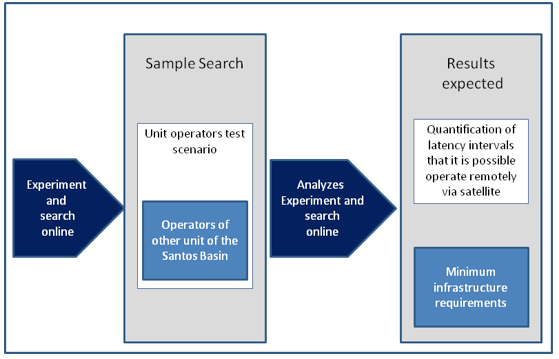
Fig. 2 Research Method
The commands generated during the experiment, in different communication network infrastructure scenarios, provided the flexibility to formulate specific questions, as well as their ranking (Likert Scale). The test experiment, associated to online search with operators, allowed conclusions about the remote operations implementation via satellite in Santos Basin, as it will be presented in the following items. From this analysis, attention points were raised, as well as opportunities for remote operations in oil production units. The experiment enabled a quantitative analysis of the influence of satellite transmission latency in three different scenarios and it was applied to the platform operators participating in the experiment and also by other production units’ operators.
In the onshore environment, the computer with the SCADA interface was monitored. The platform side was considered in the same scenario of network equipment connected to the SCADA server, linked by a private V-SAT satellite system. The analyzer network protocols equipment has been installed at both ends of the network, to collect data in real time of changes in latency. For the tests, commands were sent from the onshore remote SCADA environment to the platform SCADA system that controls the production plant, using three real situations of operation, as presented in the introduction of this article. With this constant traffic on the network, it was possible to measure the latency variation between the messages’ round trips, with two measuring points, one at each synchronized point. After this first stage, an applications accelerator was installed and configured and embedded in QoS policy for SCADA traffic, making new measurements with the same commands used in three transmission scenarios. For both situations, the RDP protocol was considered. Figure 3 presents a summary of satellite transmission scenarios and the commands used for traffic generation.
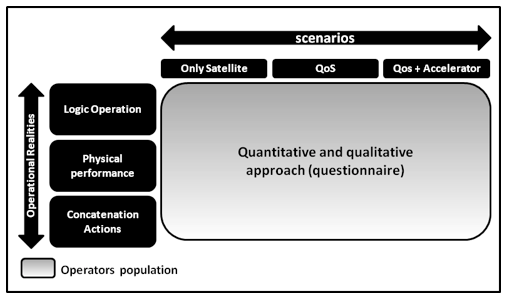
Fig. 3 Test Scenarios
Nine tests were performed within the experiment, considering three commands with different objectives and the three scenarios of satellite communication. During this phase, the latency intervals were diagnosed in which the operation was completed without any locking, interruption or improper sequencing. The range of latency was recorded and its information obtained by the analyzer network protocols equipment, measuring latency variations during the change of scenario, in real time, in milliseconds (ms). The data collected in the surveys and the data obtained from the experiment were tabulated in Microsoft Office Excel application for online research. For each response to the questionnaires, values from 1 to 5 on a Likert Scale were assigned.
As a way to estimate the reliability of the questionnaire used in the survey, the internal consistency of the scale was evaluated by Alpha Cronbach (Cronbach, 2004). The Coefficient may vary from 0 to 1 and the higher the score is, more reliable the questionnaire, by eliminating items that somehow adversely contribute to the final result of reliability analysis. Conceptually, reliability reflects how much the observed values are correlated to the true values (Carmines & Zeller, 1979). After checking the reliability of the answers to the data analysis, a Kruskal-Wallis nonparametric test was used to compare populations (Chan & Walmsley,1997).
The Kruskal-Wallis test places no restrictions on the distributions, unlike the Analysis of Variance (ANOVA), which assumes the hypothesis that all compared populations are independent and normally distributed. However, it is important to note that a non-parametric test here was necessary, since the Likert Scale was used in this study, which does not provide a normal distribution. The Kruskal-Wallis method has been used to test the null hypothesis (Ho) that all populations have the same distribution functions against the alternative hypothesis that at least one of them have different distribution functions (median or different behavior). According to Chan & Walmsley (1997), when the Kruskal-Wallis test leads to significant results, then at least one of the samples is different from the others. For p-Values smaller than 0.05, the null hypothesis that the distributions are identical should be rejected. To identify where there were differences, a confidence interval of 95% was used (-1.96 ≤ z ≤ 1.96). The experiment was then applied to a sample of 15 employees, mapped as direct participants in the production units operations.
Finally, a correlation test was used to analyse the relationship between the latency and the degree of agreement. This correlation test was conducted for Groups A and B and the different scenarios of latency. The null hypothesis (Ho) is that there is no correlation between latency and the level of agreement of the participants.
Table 3 summarizes the hypothesis tested in this research.
Table 3 Research Hypotheses to be Tested
Hypothesis |
Description |
01 |
The degree in agreement of Group A questions has the same behavior in the different scenarios of latency |
02 |
The degree of agreement of Group B questions has the same behavior in the different scenarios of latency |
03 |
There is no correlation between latency and the degree of agreement, considering the Groups A and B and the different scenarios of latency |
The research scenario elected was a gas production platform, designated in this article as P-1. It is not located in Pre-Salt area, but it is responsible for the gas production and it is installed about 160 km from the coast, in a water depth of 172 m. The platform flows the production through a pipeline to an onshore gas treatment unit and it is capable of producing 15 million m3/day of natural gas. It also receives gas from the production of other fields, playing an important role in the oil and gas production of Brazilian Pre-salt. The experiment applied to the remote operations was conducted at P-1 unit, based on the operational driver to reduce people on board and the importance of the model to be replicated to new production facilities in the Santos Basin. The test scenarios are intended to associate a level of operational complexity versus a network condition. The main elements involved in this experiment are the computers located in the remote control room and the offshore server. The remote control room should mirror exactly a local control room onboard, with full access to the automation, corporate and communication systems of the production unit. In other words, the operator will have the same resources that currently exist in the onboard control room.
In the most of the production platforms, the satellite C Band is used as a backup system of the Ku Band. Through Protocol Analyzer, the recorded latency value was checked throughout the test period. In the scenario of QoS application, beyond the satellite transmission, the QoS was considered in the application. Finally, in addition to satellite infrastructure and QoS policies, an application accelerator was introduced in the circuit that uses the RDP protocol, between the remote control room and the local control room, registering latency also by protocol network analyzer equipment.
A questionnaire was applied in three phases, in the period from December 1st to 5th, 2014, from December 15th to 19th, 2014 and, finally, from January 12th to 16th, 2015, covering all P-1 platform operators and those of other production units in Santos Basin. On January 20th, 2015, the field search was finished, since the answers percentage reached the minimum of 25%, which is reasonable for the processing of data, totaling 15 operators. The questions groups A and B objective was to know how the proposed scenarios of latency variation (satellite, satellite with QoS application, satellite with QoS and applications accelerator) affect the operator’s perception, through the experiment on operational performance during each test. Figure 4 shows the average of the responses to the questions from Group A, regarding the human response analysis, comparing by each latency scenario.
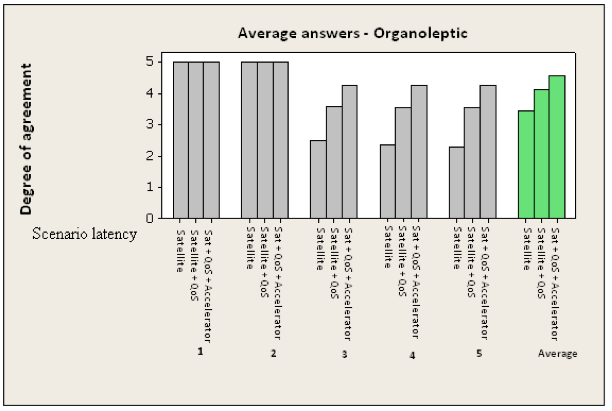
Fig. 4 Average of the responses from Group A
To measure the reliability of the questionnaire, Cronbach's Alpha Coefficient was applied to assess the internal consistency of the questionnaire in a group of two or more indicators. The Alpha values range from 0 to 1. The closer to 1, the greater is the reliability of the indicators. In this study, in Group A Cronbach's Alpha was used to measure the consistency between the questions A1 to A5, all created to capture the respondents perception, regarding factors that influence the latency, while performing the commands, with the result of 0.9891. Since this value was greater than 0.70, it was not necessary any scale purification. The coefficient shows a good interrelation between questions with a high value. The effect of redundancy was eliminated, as well as repeatability factors that could interfere in the Cronbach's Coefficient, since only 5 questions were listed. Such effects, under the chosen conditions, are practically nonexistent. Thus, it is possible to conclude that the value obtained for Cronbach's Coefficient reflects a good consistency and inter-relationship between the questions. Using the statistical nonparametric test of Kruskal-Wallis to compare the latency scenarios, the p-Value obtained, considering the null hypothesis (Ho) that all distributions are identical, was 0.000000095, i.e. less than 0.05, as shown in Figure 5.
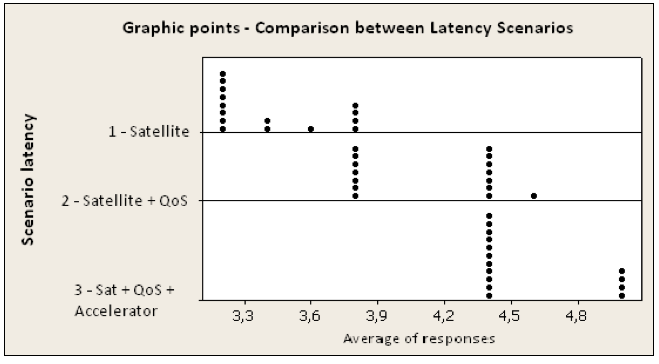
Fig. 5 Kruskal-Wallis Test of Group A
Thus, it is concluded that there are differences statistically significant in latency scenarios, i.e., the distributions are different and the null hypothesis should be rejected. In addition to the analysis, it is observed that the latency scenario, using only the satellite infrastructure, presented a z value outside the confidence limits (z = -5.08). In that way, there is a significant difference between latency scenarios, regarding the perceptions captured in Group A and the perception tends to be more positive in the satellite scenario, with QoS and accelerator. Group A presented the results the applied commands were successfully performed for each latency scenario.
Figure 6 shows the average of the answers to the questions of Group B, comparing each latency scenario.
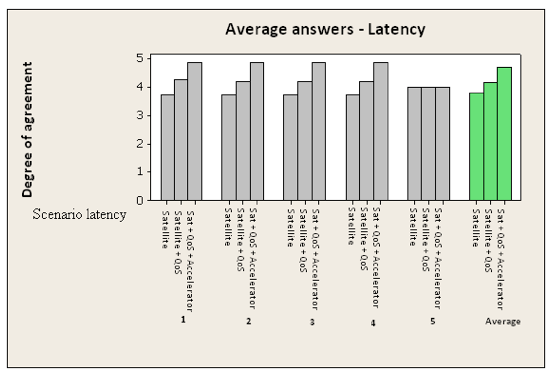
Fig. 6 Average of responses for Group B
Cronbach's Alpha coefficient was also applied to the questions B1 to B5, all of them formulated to measure in a quantitative way the variation in latency while performing the commands, with Cronbach Alpha of 0.9987. The coefficient expressed a good interrelation between questions with a high value. Thus, Cronbach's Coefficient reflects good consistency and inter-relationship between the questions. Using the Kruskal-Wallis test, the p-Value obtained, considering the null hypothesis (Ho) of all distributions is the same, was 0.008, or less than 0.05, as shown in Figure 7.
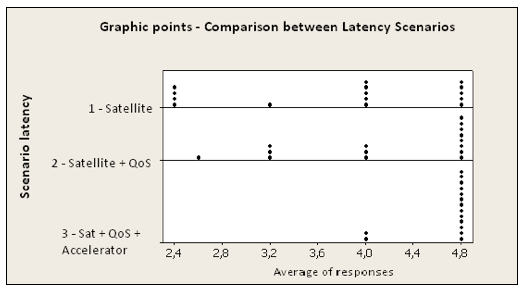
Fig. 7 Kruskal-Wallis Test of Group B
With these results, it is concluded that there are significant differences in latency scenarios, i.e., the distributions are different, the null hypothesis should be rejected. Additionally, it is noted that the latency scenarios, using a satellite infrastructure and satellite with QoS presented z values outside the confidence limits (z = -2.23, and -0.34). So, the perception tends to be positive in the satellite scenario, QoS and accelerator.
During the experiment, the values of each latency scenario test were registered. Figure 8 shows the latency values obtained.
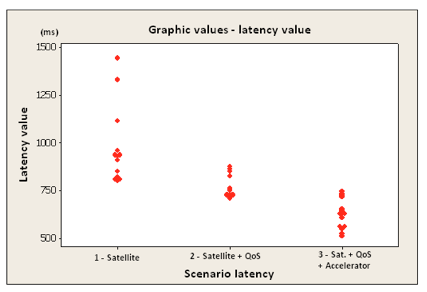
Fig. 8 Latency Values During the Experiment
Latencies exceeding 800ms reaching 1.44s were observed in the scenario of the only satellite network. For the scenario of using Satellite with QoS, the latency level was between 708 and 876ms. Finally, for the satellite’s scenario, with QoS and applications accelerator, values of latency were obtained from 512 to 745ms. With the latency values for each test scenario, it was possible to build the correlation between the values of latency and the average responses of the groups, as shown in Table 4.
Table 4 Correlation between the Values of Latency and the Average Responses for the Groups
SCENARIO |
GROUP |
LATENCY CORRELATION |
p-VALUE |
Satellite |
A |
-0.471 |
0.077 |
B |
-0.703 |
0.003 |
|
Satellite + QoS |
A |
-0.668 |
0.006 |
B |
-0.852 |
0.000055 |
|
Satellite + QoS + Accelerator |
A |
-0.444 |
0.097 |
B |
-0.523 |
0.045 |
The negative correlation in all scenarios represents that the higher the latency value, the lower the average of the grades given in the questionnaire is (using the Likert Scale). The p-Value less than 0.05 indicates a significant correlation. This correlation is being found in the satellite scenarios of Group B with p-Value of 0.003, scenario satellite and QoS for both groups with p-Value of 0.006 to 0.000 and scenario satellite, with QoS and accelerator of Group B with p-Value of 0.045.
For the Group A in scenarios with satellite, p-Value was 0.077 and the scenario of satellite, with QoS and accelerator, had p-Value of 0.097. The results are close to the significance level; however, they did not reach the significant correlation value. The range of latency between 512 to 745ms, obtained in tests with the scenario including QoS and accelerator, was the one that received the highest evaluation by operators, in which the latency presented in this range did not cause any delay in the logical sequence of the operations performed.
The results of the statistical tests are summarized in Table 5.
Table 5 Statistical Tests Results
Hypothesis |
Result |
Description |
01 |
Rejected |
p-Value < 0.05. The degree of agreement in Group A questions is different in the different scenarios of latency. |
02 |
Rejected |
p-Value < 0.05. The degree of agreement in Group B questions is different in the different scenarios of latency |
03 |
Partially Rejected* |
Hypothesis rejected for 4 of the 6 combinations (see Table 4). There is evidence of negative correlation between the latency and the level of agreement. |
*Obs: for a significance level of 0.10, all combinations present significant correlation
For the scenario of satellite transmission using protocol network analyzer prioritization policies, 60% of the measurements in the experiment were inside the latency interval recommended by this work (512 to 745ms) and 40% of latency values were above the range, as shown in Figure 9. This indicates that it is an unsecured scenario for applications in remote operations of oil production facilities or other operational demands.
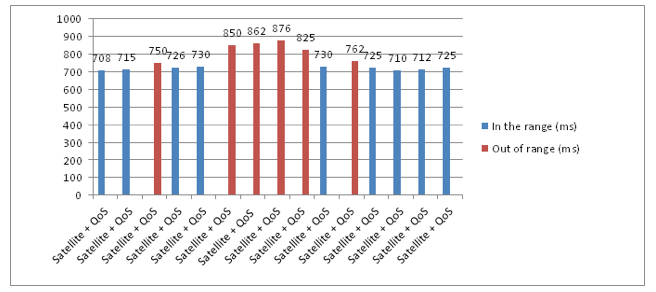
Fig. 9 Latency Values: satellite + QoS
The satellite scenario, with QoS and applications accelerator was the one that received the highest evaluation by operators, as presented in Figure 10, with 100% of the measurements within the latency interval recommended by this work.
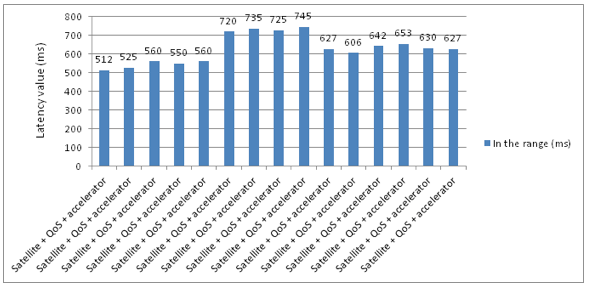
Fig. 10 Latency Values: satellite + QoS + applications accelerator
This scenario can be applied to any situation involving satellite transmission, with interesting value returns for the company from this operating model in any production and exploration oil segment.
Based on a bibliographic review, it was concluded that there are several approaches for organizations to identify tangible and intangible values of remote operations projects conducted by companies worldwide. However, this study did not find references in the literature to the latency in satellite transmission, which can be used without restriction in the oil industry. It is recommended to use the findings of this research to minimize the gap on offshore scenarios, where there is high latency telecommunications infrastructure. The possibility of testing in a real operating environment brought up the possibility of developing a methodology that allowed establishing a comparative performance model of the several scenarios of remote satellite operations. This model can be used for all oil industry in scenarios involving satellite transmission, such as remote drilling operations, stimulation vessels for well construction, balance control in ships, telemedicine and other needs. All these initiatives aim to reduce human exposure to the risks involved in production operations on an oil rig, platform or ship, reduce the transportation to the production facility, increase the availability of senior experts, provide better management of centralized activities and lower the operating costs.
The method proposed in this article, using satellite transmission infrastructure scenarios, showed that there are significant differences in each situation, identifying the latency interval necessary to prevent any delays in the logical sequence of the operations. In this context, the use of satellite transmission, without mechanisms for reducing delays generated by the network, has not been considered. This research quantified the effect of the variability of latency, making possible to identify the range in which telecommunications infrastructure of the production platforms has conditions of service for operational parameters, necessary in the communication with the production units in the remote operations model and the requirements that are necessary to improve it. Finally, it was concluded that the remote operations in production units are possible using satellite transmission systems, since mechanisms to reduce delays generated by the network are used, to obtain the latency requirements identified in this work as tolerable.
Abrão I C. (2008) Performance in Web environments with differentiation of service (QoS) in caches, network and server: modeling and simulation, Ph.D Thesis, University of São Paulo, Brazil, pp. 168.
Boon L, Fook S (April, 2003) Journey towards remote operation in Sabah offshore operations, paper presented at the SPE Asia Pacific Oil and Gas Conference and Exhibition held, 2003, Jakarta, Indonesia, Society of Petroleum Engineers. Doi: http://dx.doi.org/10.2118/80500-MS
Breu L (2007) Online-Games: Traffic Analysis of Popular Game Servers, Semester Thesis - Institut für Technische Informatik und Kommunikationsnetze, Zurich.
Cabral JE, Kim Y (2002) Multimedia Systems for Telemedicine and Their Communications Requirements, IEEE Communications Magazine, 34(7):20-27. Doi: http://10.0.4.85/35.526884
Carmines EG, Zeller RA (1979) Reliability and Validity Assessment, Series: Quantitative Applications in the Social Sciences. Sage Publications, Beverly Hills, London.
Cerutti FA (2006) A Control Plan Approach to Dynamic QoS in Voice streams in IP networks, PhD Thesis, Federal University of SantaCatarina, Florianópolis, Brazil, pp. 227.
Chan Y, Walmsley RP (1997) Learning and understanding the Kruskal-Wallis one-way analysis-of-variance-by-ranks test for differences among three or more independent groups, Phys Ther, 77(12):1755-62.
Choi YB, Krause, JS, Seo, H, Capitan, KE (2006) Telemedicine in the USA: Standardization through Information Management and Technical Applications, IEEE Communications Magazine, 44(4):41-48. Doi: 10.1109/MCOM.2006.1632648
Cisco System Official Site (accessed in 08/03/2016 – 16:41h) at http://www.cisco.com/c/en/us/td/docs/ios/12_2/qos/configuration/guide/fqos_c/qcfintro.html#wp1000873
Cramer R, Göbel D, Mueller K, Tulalian R (2012) A Measure of The Digital Oil Field Status - Is It The End of The Beginning? Paper presented at the SPE Intelligent Energy. Utrecht, The Netherlands. Doi: http://dx.doi.org/10.2118/149957-MS
Cremonezi R (2014) Implementation of remote control room for the Mexilhão Platform, paper presented at the Instrumentation Congress Control Automation, Petrobras, São Paulo, Brazil.
Cronbach LJ (2004) My Current Thoughts on Coefficient Alpha and Successor Procedures, Educational and Psychological Measurement, 64(3):391-418. Doi: http://10.0.4.153/0013164404266386
Dahmouni H, Girard A, Sansò B (2012) An analytical model for jitter in IP networks, Ann. Telecommun., 67(1):81-90. Doi: http://10.1007/s12243-011-0254-y
Dbira H, Girard A, Sansò B (2016) Calculation of packet jitter for non-poisson traffic, Ann. Telecommun., jan, p. 1-15. Doi: http://10.0.3.239/s12243-016-0492-0
Ellender D (August, 2005) Digital Architecture Technology Brings Full-Scale Automations To Remote Oil, Gas Fields, The American Oil & Gas Reporter - Houston, USA.
Falk R, Fries S (2009) Profiling the Protection of Sensitive Enterprise Multimedia Communication, paper presented at the Fourth International Conference on Internet and Web Applications and Services, IEEE Computer Society, pp. 239-246. Doi: http://doi.ieeecomputersociety.org/10.1109/ICIW.2009.41
Gilsinn, JD (2003) Ethernet / IP Race Track: Performance Metrics & Testing for your Industrial Network Interface, paper presented at the ISA Industrial Ethernet Technical Conference, Atlanta, USA.
Junior SBJ (2006) Use of new telecommunications technologies in offshore oil rigs, Master Thesis, Rio Grande do Norte Federal University, Brazil.
Lapoint D, Winslow J (2001) Analyzing and Simulation Network Taffic, Bachelor Thesis, Worcester Polytechnic Institute, USA.
Levett BA (2006) Remotely operated platforms: Fact, Fiction or Future, paper presented at the SPE Annual Technical Conference and Exhibition, San Antonio, USA. Doi: http://dx.doi.org/10.2118/103166-MS
Nielsen JJ, Madsen TK, Schwefel H (2015) On the benefits of location-based relay selection in mobile wireless networks, Ann. Telecommun., Dec, p. 1-12. Doi: http://10.0.3.239/s12243-015-0491-6
Petrobras Official Site (assessed in 08/03/2016 – 17:29h): http://www.petrobras.com.br/fatos-e-dados/utilizamos-alta-tecnologia-com-fibra-optica-para-monitorar-faixa-de-dutos.htm
Recker, S. (2003) Service Curve Based Routing Subject to Deterministic QoS Constraints, Telecommunication Systems, 24(2-4): 385-413.
Skourup C, Pretlove J, Stembridge N, Svenes M (2008) Enhanced awareness of offshore teleoperation, paper presented at the SPE Intelligent Energy Conference and Exhibition held, Amsterdam. Doi: http://dx.doi.org/10.2118/112249-MS
Valentim RAM, Viégas Jr R, Guedes LA, Fonseca ALTB (2011) Protocols performance analysis in Ethernet networks for real-time applications, Federal University of Rio Grande do Norte.
1. Federal Fluminense University, Brazil. Correspondente e-mail: cbclima@hotmail.com.br
2. Federal Fluminense University, Brazil
3. Federal Fluminense University, Brazil
4. Federal Fluminense University, Brazil
5. Federal Fluminense University, Brazil
6. Federal Fluminense University, Brazil